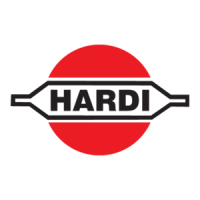5 - Operation
61
12. Turn the pressure SmartValve to “Internal tank rinsing” and circulate liquid for another 3 minutes.
13. Spray out water with cleaning agent and chemical residue. Set the spray pressure at 45-75 psi (3-5 bar). Note that the
washing water still contains active chemical and choose an appropriate area to spray out this. Alternatively the
washings can be dumped at the Filling/washing location and retained in an appropriate receptacle (E.g. slurry tank or
similar) - see section “Filling/washing location requirements”. Spot contamination and accumulation must be avoided.
Continue to spray until all liquid is expelled from the boom tubes and nozzles.
14. Shut off all nozzles by the main ON/OFF switch.
15. Rinse the sprayer again with clean water to rinse out any remaining cleaning agent. See “A. Full internal rinsing” on
page 58. Any cleaning agent that remains in the fluid system could damage the next spray chemical filled into the
main tank.
16. Include rinsing of the TurboFiller in steps 9 & 10 (above). Operate all 3 valves during this process.
17. Dismantle all filters (suction, pressure, in-line and nozzle filters) and clean the filter screens using clean water and
detergent.
ATTENTION! The rinsing nozzles cannot always guarantee a 100% cleaning of the tank. Clean manually with a high
pressure cleaner afterwards, especially if crops sensitive to the chemical just sprayed are going to be sprayed
afterwards!
÷
NOTE! It is the responsibility of the sprayer operator or owner that the sprayer is cleaned sufficiently to avoid
contamination of the environment, crop damages and health & safety hazards to operator and the public. HARDI®
cannot be held responsible for any damages or incidents related to insufficient cleaning.
Use of detergents
It is recommended to use an appropriate cleaning detergent suitable for cleaning agricultural sprayers.
• The cleaning detergents which contains a suitable lube or conditioner is recommended.
• If for some reasons this is not available and e.g. triple ammonia water is used, it is important to rinse the circuit
immediately after and add some lubricant to the rinsing water to avoid e.g. ball valves seizing up.
• Use of automotive antifreeze/radiator coolant (ethylene glycol) will protect the valves, seals etc. from drying or seizing
up.
Technical residue
Inevitably a quantity of spray liquid will remain in the system. It cannot be sprayed properly on the crop, as the pump takes
in air when the tank is about to be empty.
This Technical Residue is defined as the remaining liquid quantity in the system as the first clear pressure drop on the
pressure gauge is read. See “Technical residue” on page 83 for specific technical residues.
The residues in the tank should be diluted immediately in the relationship 1:10 with water and afterwards sprayed to the
crop just sprayed with increased driving speed. It is to be noted, however, that the liquid in the spray lines (with original
concentration) will be sprayed out first. Therefore there should be an untreated patch available to spray this out. In addition,
the rinsing tank is to be used to separately rinse pump, linkage and armature.

